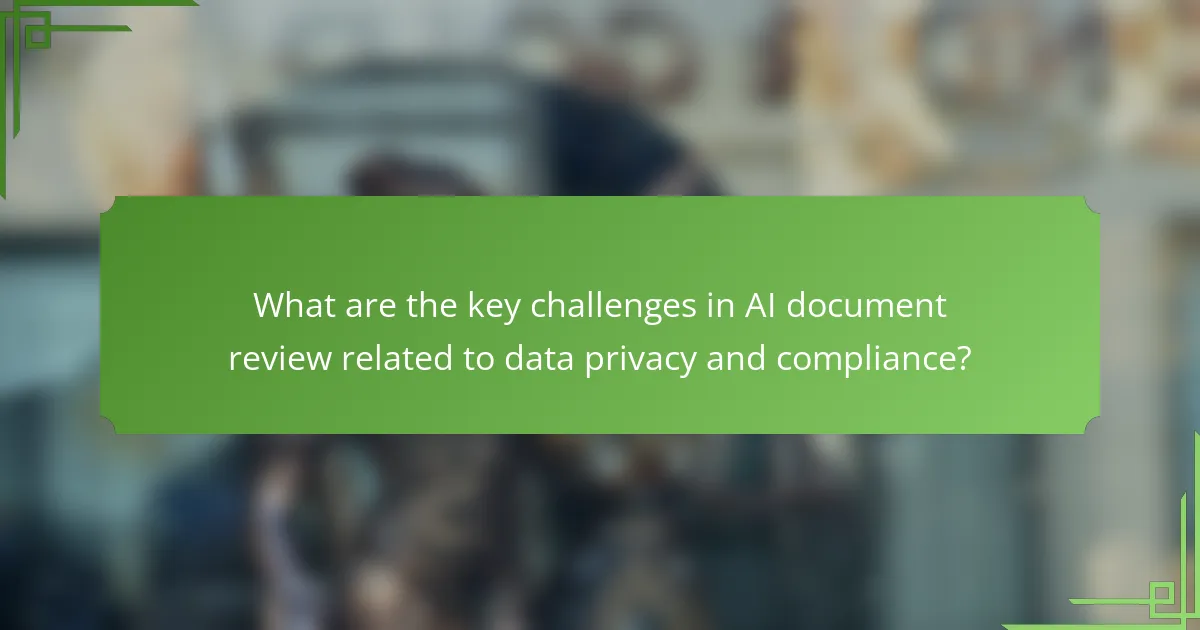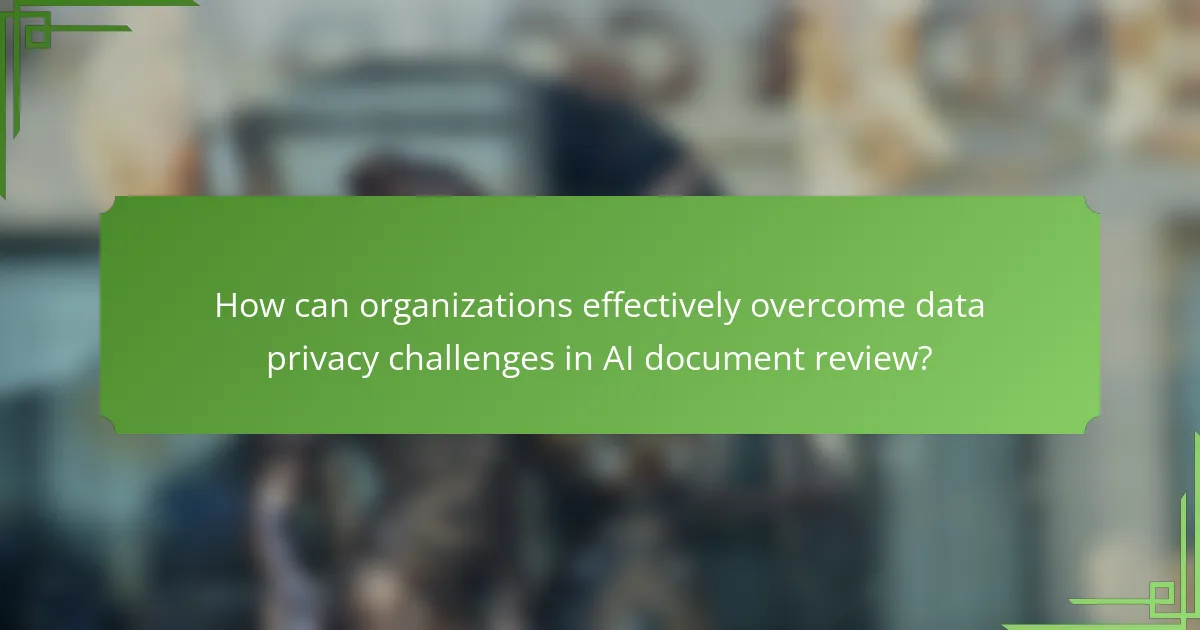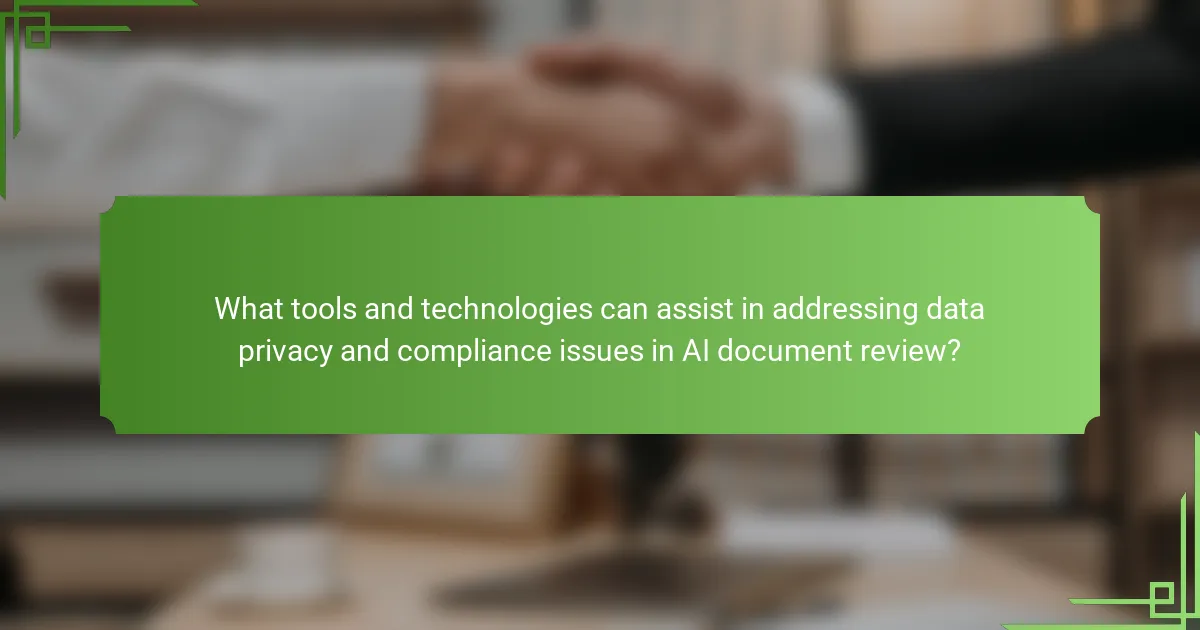
What are the key challenges in AI document review related to data privacy and compliance?
Key challenges in AI document review related to data privacy and compliance include data security, regulatory adherence, and bias mitigation. Data security is crucial as AI systems process sensitive information. Breaches can lead to significant legal and reputational repercussions. Regulatory adherence involves compliance with laws like GDPR and HIPAA. Non-compliance can result in hefty fines and legal action. Bias mitigation is essential to ensure fairness in AI outputs. Biased algorithms can lead to discriminatory practices, undermining compliance efforts. These challenges highlight the need for robust frameworks in AI document review processes.
How do data privacy laws impact AI document review processes?
Data privacy laws significantly impact AI document review processes by imposing strict guidelines on data handling. These laws dictate how personal data can be collected, processed, and stored. For instance, the General Data Protection Regulation (GDPR) in Europe mandates that organizations ensure transparency and obtain consent from individuals before processing their data. This means AI document review systems must be designed to comply with such regulations.
Additionally, data privacy laws require organizations to implement data minimization principles. This principle limits the amount of personal data collected to what is necessary for the review process. Consequently, AI systems must be programmed to filter and anonymize data effectively. Non-compliance can lead to severe penalties, including fines that can reach millions of euros.
Moreover, data privacy laws necessitate the implementation of robust security measures to protect sensitive information. Organizations must ensure that AI document review tools incorporate encryption and access controls. Failure to do so can result in data breaches, which are subject to legal repercussions under privacy laws.
In summary, data privacy laws shape the design, implementation, and operation of AI document review processes, ensuring compliance and protection of personal data.
What specific regulations must AI document review adhere to?
AI document review must adhere to regulations such as the General Data Protection Regulation (GDPR) and the Health Insurance Portability and Accountability Act (HIPAA). GDPR mandates strict guidelines on personal data processing and privacy for individuals in the EU. HIPAA sets standards for the protection of health information in the United States. Compliance with these regulations ensures that sensitive information is handled appropriately. Failure to adhere to these regulations can result in significant fines and legal repercussions. Companies must implement robust data governance practices to meet these legal requirements. Regular audits and assessments are essential to ensure ongoing compliance.
How do these regulations vary across different jurisdictions?
Regulations regarding data privacy and compliance in AI document review vary significantly across jurisdictions. In the European Union, the General Data Protection Regulation (GDPR) imposes strict requirements, including the need for explicit consent for data processing. In contrast, the United States employs a more fragmented approach, with laws like the California Consumer Privacy Act (CCPA) providing certain protections but lacking a comprehensive federal standard. Countries like Canada have their own privacy laws, such as the Personal Information Protection and Electronic Documents Act (PIPEDA), which also emphasize consent but differ in enforcement mechanisms. Additionally, jurisdictions like Singapore have their Personal Data Protection Act (PDPA) that balances business interests with individual privacy rights. These variations can lead to complexities for organizations operating internationally, as they must navigate differing legal landscapes and compliance requirements.
What compliance issues arise during AI document review?
Compliance issues during AI document review include data privacy concerns, regulatory adherence, and ethical considerations. Data privacy issues arise when sensitive information is processed without proper safeguards. Regulations like GDPR require explicit consent for data usage. Non-compliance can lead to significant fines and legal repercussions. Additionally, ethical considerations involve bias in AI algorithms affecting decision-making. Transparency in AI processes is crucial to ensure accountability. Organizations must establish robust compliance frameworks to mitigate these risks effectively.
How can organizations identify compliance risks in AI document review?
Organizations can identify compliance risks in AI document review by conducting thorough audits and assessments. They should evaluate the AI system’s algorithms for bias and transparency. Regularly reviewing data handling practices is essential to ensure adherence to regulations. Training staff on compliance standards enhances awareness and risk identification. Implementing monitoring tools can help track compliance in real-time. Engaging external experts can provide additional insights into potential risks. According to a study by the International Association of Privacy Professionals, organizations that prioritize compliance audits reduce risks by up to 30%.
What are the consequences of non-compliance in AI document review?
Non-compliance in AI document review can lead to significant legal and financial repercussions. Organizations may face hefty fines for violating data protection regulations like GDPR or CCPA. Non-compliance can also result in legal actions from affected parties, further increasing costs. Additionally, reputational damage may occur, leading to loss of customer trust and business opportunities. Compliance failures can disrupt operations and lead to increased scrutiny from regulatory bodies. These consequences highlight the importance of adherence to legal and ethical standards in AI document review processes.

How can organizations effectively overcome data privacy challenges in AI document review?
Organizations can effectively overcome data privacy challenges in AI document review by implementing robust data governance frameworks. These frameworks should establish clear policies for data handling and processing. Regular training for employees on data privacy regulations is essential. Organizations should also utilize data anonymization techniques to protect sensitive information. Employing encryption for data storage and transmission enhances security. Conducting regular audits can help identify vulnerabilities in data management practices. Utilizing AI tools designed with privacy features can further mitigate risks. Compliance with regulations such as GDPR and CCPA is crucial for maintaining data privacy.
What strategies can be implemented to ensure data privacy?
Implementing strategies to ensure data privacy involves several key measures. First, organizations should utilize data encryption to protect sensitive information both in transit and at rest. This means that even if data is intercepted, it remains unreadable without the proper decryption keys. Second, access controls must be established to limit who can view or handle personal data. This includes role-based access that restricts data access to authorized personnel only. Third, regular audits and assessments should be conducted to identify vulnerabilities in data handling processes. These audits can reveal areas needing improvement to enhance security. Fourth, employee training on data privacy best practices is crucial. Educating staff on recognizing phishing attempts and understanding data protection regulations can prevent breaches. Lastly, compliance with regulations such as GDPR or HIPAA is essential. Adhering to these legal frameworks helps ensure that data privacy standards are met. Each of these strategies contributes to a comprehensive approach to maintaining data privacy.
How can data anonymization techniques be applied in AI document review?
Data anonymization techniques can be applied in AI document review to protect sensitive information. These techniques involve removing or altering personally identifiable information (PII) from documents. For instance, names, addresses, and social security numbers can be masked or replaced with generic identifiers. This ensures that the data used for training AI models does not compromise individual privacy.
Moreover, techniques like data aggregation can be employed to summarize information without revealing specifics. This allows for the analysis of trends without exposing individual data points. A study by the National Institute of Standards and Technology emphasizes the importance of data anonymization in maintaining compliance with privacy regulations.
Implementing these techniques not only safeguards data but also enhances trust in AI systems. This is crucial in fields where document review is sensitive, such as healthcare and legal industries.
What role does encryption play in protecting sensitive data?
Encryption plays a critical role in protecting sensitive data. It transforms data into a coded format that can only be accessed by authorized users. This process prevents unauthorized access during storage and transmission. For instance, encryption protocols like AES (Advanced Encryption Standard) are widely used to secure sensitive information. According to the National Institute of Standards and Technology (NIST), encryption is essential for maintaining data confidentiality and integrity. By using encryption, organizations can comply with regulations such as GDPR and HIPAA, which mandate the protection of personal data. Thus, encryption is a fundamental tool for safeguarding sensitive information against breaches and cyber threats.
How can organizations maintain compliance while using AI for document review?
Organizations can maintain compliance while using AI for document review by implementing robust data governance frameworks. These frameworks should include data classification, ensuring that sensitive information is identified and handled appropriately. Regular audits of AI systems can help verify compliance with relevant regulations. Organizations must also ensure that AI algorithms are transparent and explainable. Training staff on compliance requirements is essential for effective implementation. Additionally, obtaining explicit consent for data usage from individuals is crucial. Monitoring AI outputs for bias and inaccuracies can prevent compliance violations. Finally, staying updated on legal changes related to data privacy ensures ongoing compliance.
What best practices should be followed for compliance in AI document review?
Best practices for compliance in AI document review include ensuring data privacy, implementing robust security measures, and maintaining transparency. Organizations should anonymize sensitive data to protect individual privacy. Regular audits should be conducted to assess compliance with regulations. Training staff on compliance requirements is essential for effective implementation. Using explainable AI models helps in understanding decision-making processes. Documenting all processes supports accountability and traceability. Collaborating with legal experts ensures adherence to evolving regulations. Finally, establishing a clear data retention policy is crucial for compliance.
How can regular audits improve compliance in AI document review processes?
Regular audits can significantly enhance compliance in AI document review processes by systematically evaluating adherence to regulations. These audits identify gaps in compliance and ensure that AI systems align with legal standards. Regular assessments help in maintaining transparency, which is crucial for building trust with stakeholders. They also facilitate the detection of biases or inaccuracies in AI algorithms, ensuring fair and accurate document reviews. Furthermore, audits can uncover potential risks associated with data handling and processing, allowing for timely mitigation strategies. According to a study by the International Association of Privacy Professionals, organizations that implement regular audits see a 30% reduction in compliance-related issues. This evidence underscores the importance of regular audits in fostering a culture of compliance within AI document review processes.

What tools and technologies can assist in addressing data privacy and compliance issues in AI document review?
Data privacy and compliance issues in AI document review can be addressed using several tools and technologies. Data encryption software protects sensitive information during processing. Access control systems ensure that only authorized personnel can view documents. Compliance management platforms help organizations track adherence to regulations like GDPR and HIPAA. AI-driven data masking tools anonymize personal data in documents. Auditing tools provide oversight and traceability of data access and usage. These technologies work together to enhance security and compliance in AI document review processes.
What are the most effective AI tools for document review?
The most effective AI tools for document review include Relativity, Kira Systems, and Logikcull. Relativity is known for its powerful e-discovery capabilities. It offers advanced search features and AI-driven analytics. Kira Systems excels in contract analysis and extraction of key data points. It uses machine learning to identify relevant clauses and terms. Logikcull simplifies the document review process with user-friendly interfaces. It automates data organization and provides secure sharing options. These tools enhance efficiency and accuracy in legal and compliance contexts.
How do these tools enhance data privacy and compliance?
These tools enhance data privacy and compliance by implementing advanced encryption methods. Encryption protects sensitive data from unauthorized access during storage and transmission. They also facilitate automated compliance checks against regulations like GDPR and HIPAA. This automation reduces human error and ensures adherence to legal standards. Furthermore, these tools often include robust audit trails. Audit trails track data access and modifications, promoting accountability. They also support data anonymization techniques. Anonymization helps in protecting personal information while allowing data analysis. Overall, these features collectively strengthen data privacy and compliance efforts.
What features should organizations look for in AI document review tools?
Organizations should look for accuracy, speed, and scalability in AI document review tools. Accuracy ensures that the tool correctly identifies relevant information and reduces errors. Speed allows for rapid processing of large volumes of documents, which is crucial in time-sensitive situations. Scalability enables the tool to handle increasing amounts of data without loss of performance.
Additionally, features like data security and compliance with regulations are essential. Data security protects sensitive information from breaches. Compliance ensures adherence to legal standards, such as GDPR or HIPAA, which is vital for avoiding penalties. User-friendly interfaces enhance usability for team members. Integration capabilities with existing systems streamline workflows.
These features collectively enhance the effectiveness and reliability of AI document review tools in organizational settings.
How can organizations integrate compliance frameworks into their AI document review processes?
Organizations can integrate compliance frameworks into their AI document review processes by establishing clear guidelines. These guidelines should align with relevant regulations such as GDPR or HIPAA. Organizations must also implement regular audits to ensure adherence to these frameworks. Additionally, training staff on compliance requirements is essential for effective integration. Utilizing AI tools that are designed with compliance features can enhance this process. Organizations should also incorporate feedback mechanisms to improve compliance continuously. Finally, documenting all processes and decisions related to compliance is crucial for accountability and transparency.
What frameworks are most commonly used for compliance in AI document review?
The most commonly used frameworks for compliance in AI document review include GDPR, CCPA, and ISO/IEC 27001. GDPR (General Data Protection Regulation) is a comprehensive data protection law in the EU that governs how personal data is processed. CCPA (California Consumer Privacy Act) provides California residents with rights regarding their personal information. ISO/IEC 27001 is an international standard for information security management systems. These frameworks help organizations ensure they meet legal and regulatory requirements while using AI for document review. Compliance with these frameworks mitigates risks associated with data privacy and enhances trust in AI systems.
How can organizations customize compliance frameworks to suit their needs?
Organizations can customize compliance frameworks by assessing their specific regulatory requirements and business objectives. They should conduct a thorough risk assessment to identify unique compliance challenges. Tailoring policies and procedures to address these challenges is essential. Organizations can also engage stakeholders to ensure the framework aligns with operational realities. Regular training sessions can be implemented to educate employees on the customized framework. Additionally, utilizing technology tools can help automate compliance monitoring. Continuous feedback loops should be established for ongoing improvements. These steps ensure that the compliance framework remains relevant and effective.
What practical steps can organizations take to improve data privacy and compliance in AI document review?
Organizations can improve data privacy and compliance in AI document review by implementing several practical steps. First, they should conduct a comprehensive data privacy assessment. This assessment identifies vulnerabilities and compliance gaps within current processes. Next, organizations must establish clear data governance policies. These policies define data handling, access controls, and retention schedules.
Training employees on data privacy and compliance is crucial. Regular training sessions ensure that staff understand their responsibilities and the importance of data protection. Additionally, organizations should utilize encryption technologies. Encryption protects sensitive data during storage and transmission.
Implementing robust access controls is vital. Limiting access to sensitive information reduces the risk of unauthorized exposure. Organizations should also incorporate audit trails. Audit trails provide transparency and accountability in data handling practices.
Finally, staying updated with regulations is essential. Organizations must monitor changes in data privacy laws to ensure ongoing compliance. These steps collectively enhance data privacy and compliance in AI document review.
The main entity of this article is AI document review, specifically focusing on data privacy and compliance issues. The article outlines key challenges such as data security, regulatory adherence, and bias mitigation that organizations face when implementing AI in document review processes. It discusses the impact of data privacy laws like GDPR and HIPAA on these processes, the importance of compliance, and the consequences of non-compliance. Additionally, it offers practical strategies for organizations to enhance data privacy and compliance, including the use of encryption, data anonymization, and regular audits. The article emphasizes the necessity of robust frameworks and tools to navigate the complexities of data privacy in AI document review.